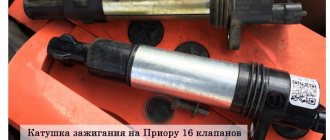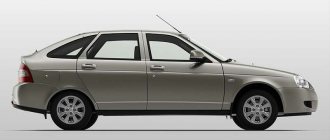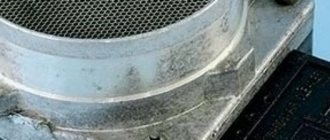The tank volume of the Priora car “inherited” from its predecessors - 43 liters. How many years have passed, the VAZ-2108 was equipped with a gas tank of the same volume, the same was installed in the VAZ-2110, and after the VAZ-2110 was removed from the assembly line, and after the launch of production of the Lada Priora, the number of liters did not change! However, the fuel tank of a Priora car (sedan, hatchback and station wagon) has its own article number (catalog number) - it is the same on all three bodies. Priora should not despair: this fuel tank volume is considered the most optimal, for which there is a simple explanation:
Priora is a city car with low consumption on the highway and average consumption in the city. In the city, it is easy for a motorist to find a gas station, fill the tank regularly; on the highway, it is easy to calculate the distance to the nearest gas station, and then refuel on time. The volume (capacity) of the tank on the Priora is ideal for the operating conditions for which it is intended.
Lada Priora with a tank volume of 43 liters was produced from 2007 to 2013 - there were no changes. The volume does not depend on the body - be it a sedan, hatchback, station wagon or coupe - or on the configuration. The tank capacity on the Priora is designed to allow you to get from point A to point B within the city, sometimes stopping at a gas station. The number of liters, of course, can be called “untrue”: curious Prior owners found out that the car is literally filled “to the brim” with 49 liters of gasoline.
Standard gas tank - article number and price
The standard gas tank has article number 21082110101370. The price ranges from 3,500 to 5,500 rubles. All of them are produced at the same factory, the issue of pricing lies with the conscience of the seller. A used gas tank costs from 1000 to 2000 rubles. No need to be cheap - a gas tank is not just a plastic container, it should not be damaged. The quality of a gas tank used by someone can be doubted.
The dimensions and size of the tank on the Priora are such that the tank will fit in its predecessor models: the volume of the tank has not changed. A full tank always fills up to 43 liters.
Removing and installing the tank
Removing the gas tank on a Priora begins with compiling a set of tools:
- Set of wrenches;
- Set of heads;
- Flat and Phillips screwdrivers;
- Pliers.
It will be most convenient to dismantle the fuel tank without gasoline, or with a small amount of it. The work will take place in the following order:
- Drive the car into a pit or overpass, secure it in place by tightening the handbrake;
- Remove the rear seat completely, and then the part of the carpet under which the fuel pump cover is located;
- Remove the two screws that secure this cover and remove it. In front of you is the fuel pump;
- Find the wiring harness block, bend the clamp, after which you can disconnect the wiring block;
- Start the engine, wait until it stalls (the fuel has completely drained out of the ramp). Then equalize the pressure in the fuel drives by turning the starter for about three seconds;
- Remove the negative terminal of the battery;
- Squeeze the plastic clamp on the fuel pump fitting (there are two of them). Disconnect the tube from the pump fitting;
- On the second fitting, bend the second clamp, disconnect the other tube;
- Find the air outlet hose and loosen its clamp. Remove the hose from the pipe;
- Remove the tube responsible for draining gasoline from the separator by clamping the clamps on the sides;
- Where the connecting hose from the fill pipe is attached to the tank nozzle, loosen the clamp. Remove the hose;
- We proceed to direct dismantling. Remove the two clamps that secure the tank;
- If you are going to change the tank, then it is worth changing all the supply hoses. Remove the air outlet hose from the tank fitting;
- Go back upstairs to where you removed the cover under the seats. The nut securing the “-” must be removed. After this, you can remove the wire itself;
- Unscrew the remaining seven nuts that secure the pressure ring and remove it. Carefully remove the pump, tilting it to the side to keep the fuel gauge sensor lever intact;
- There is an O-ring (rubber) on the tank flange. It may have cracked over time, so it might be a good idea to replace it;
- Remove the filler pipe filler plug, and then remove the bottom bracket securing it. Strictly after this, dismantle the upper bracket;
- Remove the upper end from the facing part of the filling pipe and remove the pipe. Remove the facing part itself. If the elastic band is not damaged, it can be put back;
- Remove the hose from the filler neck.
How far can you travel?
The volume of the Priora's fuel tank is designed so that the car can travel a certain distance without refueling. In many ways, the power reserve is individual – that is, it depends on the driver’s driving style. Sharp acceleration increases fuel consumption, and the same thing happens if you select the wrong gear. But there is not only a human factor. Firstly, different amounts of fuel are consumed in the city, on the highway and in the combined cycle when recalculated per 100 km.
Secondly, a lot depends on the engine: the Priora was equipped with engines with a displacement of 1.6 liters with eight and sixteen valves and a power of 81, 87, 98 and 106 hp. Plus, since 2013, after restyling, the Priora was equipped with a robotic automatic transmission. The most popular choice is a sixteen-valve engine with 98 hp. along with manual transmission. Calculations will be given for it.
On a full tank
So, the configuration we have chosen consumes:
- 9.8 l per 100 km in the city;
- 5.6 l per 100 km on the highway;
- 7.2 liters per 100 km in the combined cycle.
With the maximum filling of the gas tank, the Lada Priora, powered by AI-95 (according to the passport!) will travel:
- 438.77 km in the city;
- 767.88 km on the highway;
- 597.22 km combined cycle.
It is worth subtracting at least 30 km from these figures so as not to kill the fuel pump - if it pumps air and debris from the bottom of the gas tank, its service life will gradually come to an end.
When the gas pump on the dashboard came on
If the gas station icon lights up on the panel, then this is not good - there is less than 10 liters left in the gas tank. This is, one might say, a critical situation. Of course, there have been cases when a person drove with a “light bulb” another 90 km along the highway, but it is better not to risk it - limit the radius of the gas station search area to 20 km immediately after you see the light bulb.
Technical modification data
It would be wrong to mention that the Priora hatchback is a good budget city car without backing these words up with facts. The car belongs to class B, it is front-wheel drive, the environmental class is Euro 4. The five-door hatchback has a curb weight of 1088 kg, and a maximum weight of 1578 kg.
The suspension in the hatchback was not strengthened compared to the sedan. The front is independent spring, the rear is semi-independent spring. The front brakes are ventilated discs and the rear brakes are drums. The pre-restyling version works only with a manual transmission, the restyled version – with a robotic automatic transmission. The main differences between restyling and pre-restyling are modified headlight optics and a slightly redesigned interior (steering wheel, dashboard, center console, multimedia).
Lada Priora tank how many liters
The popular domestic Lada Priora borrowed the tank volume from its predecessor. And many potential owners are interested in the question, how many liters are in the tank? We will definitely answer this pressing question in this material, and also tell you a lot of useful information about the Lada Priora tank, including what troubles to expect, how much it costs and most importantly, what is the capacity of the gas tank.
A short excursion into history, the legendary VAZ-2108 was equipped with a tank, the volume of which was absolutely the same as that of the VAZ-2110 later. The “Ten” has long been discontinued, and the Priora is being produced, but the capacity of the gas tank has not changed since the days of the “Eight”. At the same time, Lada Priora has its own personal article number (that is, catalog number) for the tank. The number is identical for each body: sedan, exactly the same for a station wagon and, accordingly, for a hatchback. According to numerous owners of the car we are considering, its tank volume is the most optimal, and all because Priora is a 100 percent city car with average fuel consumption in urban conditions and low fuel consumption on the highway. According to information from the car manufacturer, the tank volume is 43 liters, however, Lada Priora owners have found through experience that the tank capacity is actually up to 49 liters.
Trunk volume and body dimensions of Lada Largus
This brand is available in 3 versions:
- passenger;
- increased capacity;
- cargo van.
The average trunk size of this car is 135 liters; if you fold the third row of seats, it increases to 560 liters. Exactly the same body volume of a 5-seater station wagon. A maximum capacity of up to 2350 liters is possible if all seats are folded down. With the third row seats folded, the trunk length is 90 cm, and with the second and third row seats folded, it is 174 cm.
As we can see, the cargo van is much more spacious than other Largus options; it is perfect for large shipments. The passenger version and the increased capacity also accommodate cargo, but in small quantities. The first type is generally intended for maximum hand luggage, and the second - for small items.
Catalog number and cost of the standard Priora fuel tank
The official article number for the Priora fuel tank is: 21082110101370. Its cost is 3.5-5.5 thousand Russian. rub. In addition, now you can easily purchase a used gas tank for our car in excellent condition. The price for such a tank varies between 1-2 thousand Russian. rub. You can also take into account that the Priora’s tank is exactly the same as that of the “eight” and “ten”, with the same volume. If you need to find out about the traffic police, fines, traffic rules and car insurance, visit https://progai.info/.
How to remove and install a fuel tank yourself
In order to replace a faulty tank on a LADA Priora you will need the appropriate set of tools:
- Pliers.
- Wrenches included in the set.
- Screwdrivers, both Phillips and flathead.
- Heads included.
Step-by-step instructions for replacing the fuel tank on a Priora with your own hands:
- The fuel tank of the Lada Priora should contain as little fuel as possible. Therefore, it is better to first use as many liters of fuel as are left in the car.
- The car will have to be driven onto an overpass, or, if desired, into a pit.
- At this stage, you have to remove the rear sofa and fold back the carpet, under which the fuel pump cover is actually located.
- The cover is secured with a pair of screws, which must be unscrewed and the cover removed. You will see a device called a fuel pump.
- The wire block can be disconnected by bending the special clamp.
- We start the engine and wait until it stalls.
- Let's compare the pressure. This is done with the help of a starter, which needs to be turned for 3 seconds.
- Remove the “-” terminal from the battery.
- Squeezing the plastic clamp, disconnect the fuel pump tube from the fitting.
- We do the same with the second fitting.
- Now you should loosen the clamp of the air outlet hose and remove it from the pipe.
- We remove the tube that is responsible for draining the fuel from the special compartment of the separator. This can be done by clamping the latches on the sides.
- We also disconnect the hose going from the filler pipe to the tank nozzle.
- Remove the 2 clamps holding the gas tank.
- If you need to completely replace the tank, you will need to change all the supply hoses without exception. Don't forget to remove the air outlet hose from the tank fitting.
- Return to the place where you removed the cover under the rear seats. Make sure that the nut securing the “-” is removed.
- We remove the wire.
- Remove the pressure ring; for this purpose you need to remove 7 nuts.
- We remove the pump very carefully; when removing it, you need to tilt it slightly to the side so as not to damage the fuel sensor.
- There is a rubber O-ring on the gas tank flange. It needs to be replaced because it becomes cracked over time.
- The neck plug through which fuel is poured into the pipe must be removed, after which we remove the lower bracket on which it is supported. It is important to remove the top bracket only after this.
- We remove the upper end from the filling pipe, or rather from its facing part, then remove the pipe. After this we remove the facing part. You can put the elastic back if it is not damaged.
- Remove the hose from the filler neck.
- After everything has been removed carefully and in the correct order, you can install a new unit, and if necessary, replace all seals, gaskets and hoses that are damaged, even if they are minor. Correct work will ensure stable operation of the fuel sensor and fuel pump.
Types of correctors
Car owners often wonder what a headlight range control is and whether they can install it themselves. Depending on the device, there are several types of systems:
- electromechanical;
- hydromechanical;
- mechanical;
- automatic.
Automatic technology is the most expensive and effective. Such a system reads the body position data and independently adjusts the light beam. Other types are controlled manually using a washer or wheel located in the cabin.
Electromechanical
The electric headlight corrector allows you to adjust the angle of light from the interior. The driver independently selects the position of the washer depending on the load on the car.
The system does not have additional sensors on the vehicle's levers, so if the angle is chosen incorrectly, the light may be adjusted incorrectly. In this case, the low beam lamps will dazzle another vehicle when driving in the dark.
In the electric corrector, the motors change the position of the rod depending on the selected key indication in the cabin.
Components:
- electrical control element;
- tilt angle regulator;
- motors.
Hydromechanical
Hydrocorrector headlights are rare nowadays. A handle is installed in the cabin, which is directly connected to lines filled with liquid. When the lever is turned, pressure appears and is transmitted to the hydraulic pistons. Next, the force is transmitted to the rod, and parts of the reflector body are set in motion.
The system is fully controlled by the driver from inside the cabin. In winter, the liquid freezes and becomes noticeably thicker. It takes more effort to control the rod that affects the angle of the light.
The lines are constantly under pressure and eventually fail. The channels begin to leak, and the system does not gain the required traction when turning the knob.
If you choose the wrong angle, you may be exposed to light and dazzle other road users.
Mechanical
A mechanical corrector with cables that move the rod to adjust the angle of the reflector in the headlight was installed only on older cars. The system turned out to be unreliable and often failed after water got into the cable jacket. This effect leads to souring of the device.
A manual mechanical corrector should be used at least 2-3 times a month and the system should be periodically lubricated with oil. In winter, the system often soured and did not allow adjusting the headlight beam angle. Full lubrication of the cables helped restore functionality.
The corrector consists of the following components:
- power cables;
- control handle;
- gearbox with rod.
Currently, this type of corrector, which requires constant attention, is not used due to the expensive maintenance of the system.
Auto
Auto-corrector of headlights is most accurate in selecting the angle of light. The option is installed only in cars with xenon lamps and provides the best visibility at night.
There are no additional adjustment keys installed in the cabin; the system does everything independently in automatic mode.
The service life of the option is 10-15 years depending on operating conditions. Only the headlight range control sensor, which is installed on the car's arm and transmits a signal to the unit, may require repair.
Also among the components that require special attention is the chassis position linkage. Load control parts are installed from 1 to 3 depending on the complexity of the chassis. Over time, the moving balls sour and break off under load. To prevent breakdowns, it is necessary to lubricate the ball joints with copper grease every 40-50 thousand kilometers. This is not regulated in the vehicle operating literature, but it will help preserve the corrector components and avoid unpleasant incidents.
How long does a full tank last in a Priora?
Like any other car, the Lada Priora in a sedan body, and even in a station wagon body, and accordingly a hatchback, has a certain gas tank capacity. How long you can drive if your car's tank is full depends greatly on where you're driving (in the city or on the highway), as well as on your driving style.
Not everything depends on the human factor; how many liters of fuel will be consumed while driving is also influenced by the cost of the power unit. LADA Priora is equipped with a 1.6 liter engine. with 8 and 16 valves, power 81l/str, 87l/str, 98l/str, and even 106l/str. Plus, after restyling in 2013, the car began to be equipped with a robotic gearbox. However, the most popular option among consumers remains a 16-valve engine with a power of 98 l/hp with a manual transmission. Based on this aggregate, we have given approximate calculations.
Station wagon
Today, three types of bodies are produced: sedan, hatchback and station wagon. Since you already know everything about the first two, we’ll tell you about the station wagon. This is a very practical car, the luggage compartment is spacious enough to carry large loads, and you can easily convert the rear seat into a bed.
If you look at this type of body from a technical point of view, its volume is 444 liters, and with the sofa folded - about 800 liters (up to the level of the windows).
Characteristics of the trunk volume of the station wagon (mm):
- width – 1500, between wheel arches – 930;
- length – 985 and 1640 with the sofa folded;
- the distance from the floor to the trunk shelf is 560, and to the lid – 845;
- trunk door opening size – 820.
The station wagon car itself has very serious dimensions (mm):
- in length is 4340;
- width – 1680;
- in height – 1508;
- ground clearance - 170.
Now the Lada is considered the most expensive among the Priors, but the price of the car is equivalent to its quality. You won't be able to find a cheaper station wagon among foreign cars.
How much fuel does Priora consume?
The configuration indicated above on the LADA Priora consumes: for every 100 km of travel in city mode 9.8 liters, while driving on the highway - 5.6 liters, and accordingly in the combined cycle the consumption will be 7.2 liters. If you fill the entire volume of the car’s tank, it will be able to cover the following distances: when driving around the city it will be enough for 439 km, while driving on the highway the distance will be 768 km, and accordingly in the combined cycle – 598 km. Of course, these are average figures, and it is unlikely that every driver will have exactly these figures. As mentioned above, everything depends on many factors. However, theoretically, the capacity of the gas tank allows you to travel approximately above the specified distances.
Other parameters of Lada Priora Hatchback:
| General parameters of Lada Priora Hatchback bodies | |
| General view General view of bodies | Length min (mm) Minimum overall length of the car for different modifications of Lada Priora Hatchback |
Measured in millimeters (mm)
| Length max (mm) Minimum overall length of the car for different modifications of Lada Priora Hatchback Measured in millimeters (mm) | Modifications Number of modifications of the model in our database | ||
| (General form) | 4210 (mm) | 4210 (mm) | 2 |
| Lada Priora Hatchback body parameters |
| Parameter Body parameter |
Caution: the above data are the official figures of the manufacturer, however, please note that the information is for reference only and does not guarantee absolute accuracy.
Source
Story
The fuel tank of the Lada Priora was inherited from its predecessors, such as the VAZ 2110. The volume of the fuel tank in the Priora is almost 43 liters. This volume was considered by AvtoVAZ engineers to be proportional to the engine volume, because back in the 80s, a gas tank of exactly the same volume was installed on the VAZ 2108. How much time has passed since those years, and the volume of the tank has not changed.
After the completion of production of the VAZ 2110 in 2007, the fuel tank was completely pumped by the then newest car of the Volga plant - Priora. It should be noted that the fuel tank was not completely copied from the VAZ 2110, but still has some bug fixes.
For example, in a VAZ 2110, the fuel pump glass was fastened with nuts to studs with a diameter of 5 mm, which, after several processes of removing and installing the glass, simply left these studs in a terrible state. In the best case, the threads on the studs were licked off, and in the worst case, when tightening, the stud was completely torn off from the tank.
In Priora, this problem was solved by installing new studs with a larger diameter, namely 6mm. This modification greatly strengthened the fixation of the fuel pump and increased the tightness of the fuel tank.
What changes in the interior awaited car enthusiasts?
The interior design has undergone major changes. Firstly, qualitatively new materials were used. For example, the manufacturer began to use soft-look plastic, which not only resembles natural leather, but is also extremely resistant to external influences. The linings on the interior trim of the doors and front panel are made from it.
Secondly, the dashboard and dashboard have changed for the better. Now the updated Lada Priora white boasts a 7-inch touch screen in the luxury version, which can be used to control music and navigation. But in budget versions, a screen is used on which the on-board computer readings are displayed. All expensive trim levels are equipped with modern climate control.
Thirdly, the appearance and design of the steering column has changed, it has become more modern and comfortable for the driver’s hands, and the seats in the 2015 Priora are also more comfortable and better.
Why 43 liters?
Sometimes people have the question, “Why only 43 liters?”, because many foreign cars with the same engine capacity are equipped with a much larger fuel tank. The answer to this question can be summarized into several points.
Priora is a universal car with a small engine capacity. As you know, the smaller the engine volume, the lower its consumption. Also, Priora is most often equipped with a manual transmission, which also makes its consumption much lower than that of foreign cars with an automatic transmission.
Priora has average fuel consumption in the urban operating cycle and fairly low consumption when operating on the highway. In the city it is quite easy to find a gas station and top up fuel if its availability has crossed the minimum mark. As for the route, the Priore is more than enough for this fuel tank capacity to cover long distances. The average consumption of the Priora on the highway is from 5 to 6 liters when driving in 5th gear and at a speed of 100 km/h.
By the way, the volume of the tank is exactly 43 liters, but if you fill the fuel to the very neck, then almost 48 liters of fuel will fit into the Priora. This is explained by the rather long filler neck, which holds almost 5 liters of fuel.
Major breakdowns and malfunctions
There are several main reasons for tank breakdowns after which it needs to be repaired or replaced with a new one.
The studs securing the fuel pump cup are one of the main reasons for tank failure and the reason for its repair. Although the diameter of the studs was increased in Priora, it is not difficult to tear them off.
A tank breakdown occurs when driving on country roads, since the tank does not have any protection and is located in a vulnerable place.
Corrosion in the tank is also one of the reasons for dismantling the tank and cleaning it from dirt or even replacing it with a new one.
How far can you travel?
The question of how long you can drive on a full fuel tank is, of course, strange, because each driver has his own driving style, and the operating conditions of the car are always different. Some people move around the city, while others move exclusively along the highway, and here, of course, the numbers will vary. But for a more detailed answer, let's look at each of the options.
On a full tank you can drive:
- On the highway at a speed of 90 km/h in 5th gear, almost 780 km;
- City cycle 440 km;
- Combined cycle (city, highway) 580 km;
Consumption per 100km:
- On the highway 5.6 liters;
- In the city 8-9 liters;
- In the mixed cycle 7 liters;











